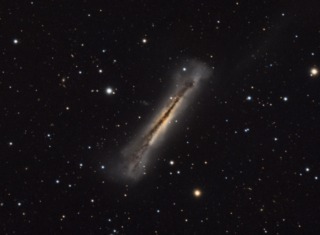
- Constellation: Leo
- Right Ascension: 11h 20m 17.0s
- Declination: +13° 35′ 23″
- Distance: 35 million ly
NGC 3628 is often called the Hamburger Galaxy or Sarah's Galaxy forms part of the Leo triplet of galaxies along with Messier 65 and Messier 66. The galaxy is an unbarred spiral galaxy seen edge on from our perspective. A broad band of dust along the equatorial axis blocks most of the view of the disc and nucleus of the galaxy. The galaxy also shows evidence of past interactions with other galaxies as a long 300,000 light year tidal tail can be seen in long exposure images extending from it, along with with edges of the spiral disc being warped.
- Details
- Category: Galaxies
- Telescope: Explore Scientific 127 Refractor
- Camera: Atik 314l+
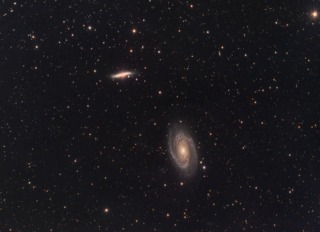
- Constellation: Ursa Major
- Right Ascension: 09h 55m 33.2s
- Declination: +69° 3′ 55″
- Distance: 11.8 million ly
Messier 81 is a spiral galaxy located in Ursa Major, it is the largest galaxy in the M81 galaxy group, which is a relatively close grouping of galaxies. It is often called Bode's Galaxy after its discovery by Johann Bode in 1774.
Messier 82, the other prominent galaxy in the image is often called the Cigar Galaxy, it was also first discovered by Johann Bode. M82 is a star burst galaxy as it is undergoing an increased rate of star formation, possibly triggered by interaction with M81 in the past.
Imaged with the 80mm refractor and a Zwo 1600 mono camera.
- Details
- Category: Galaxies
- Telescope: EDT 80mm Reftactor
- Camera: ZWO 1600 MM
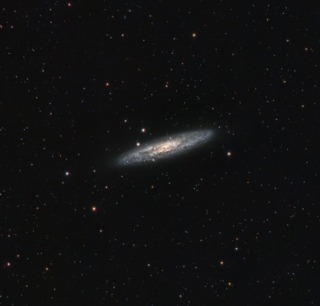
- Constellation: Sculptor
- Right Ascension: 00h 47m 33s
- Declination: −25° 17′ 18″
- Distance: 11.4 million
NGC 253 or often called the Silver Dollar Galaxy is dominated by it's dust patterns. Discovered by Caroline Herschel in 1783, it is one of the brighter galaxies visible. NGC 253 is a member of the Sculptor Group of galaxies, one of the nearer galaxy groups. Only one supernova has been detected in NGC 253 so far.
- Details
- Category: Galaxies
- Telescope: EDT 80mm Reftactor
- Camera: ZWO 1600 MM
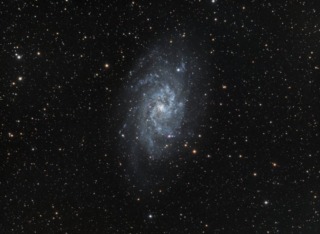
- Constellation: Triangulum
- Right Ascension: 01h 33m 50.02s
- Declination: +30° 39′ 36.7"
- Distance: 3.2 million ly
Messier 33, or also called the Triangulum Galaxy, is a spiral galaxy located in the constellation of Triangulum. Sometimes it is referred to as the Pinwheel galaxy, but that name is more associated with Messier 101. It is a member of the Local Group of galaxies and is possibly a satellite galaxy of Andromeda. The galaxy contains several large H II regions of molecular clouds visible as pinkish-red regions. It lies at distance of about 3 million light years away, and is home to an estimated 40 billion stars.
Imaged with the ED80cft refractor and ZWO 1600MMC mono camera.
- Details
- Category: Galaxies
- Telescope: EDT 80mm Reftactor
- Camera: ZWO 1600 MM
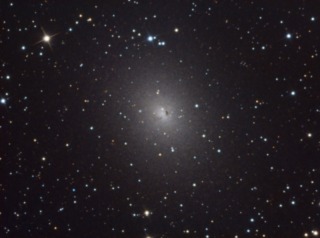
- Constellation: Cassiopeia
- Right Ascension: 00h 38m 57.970s
- Declination: +48° 20′ 14.56″
- Distance: 2 million ly
Dwarf spherical galaxies are not the most photogenic of galaxies, but sometimes I like to image stuff off the beaten track to see what I can find.
I was able to track down and identify some of the globular clusters that surround this galaxy. One of these, FJJ-VI was originally classified as a globular, but later studies by Hubble point to it being a distant elliptical galaxy. The color is noticeable much more reddish. FJJ-II is listed at 19.7 magnitude in the visual band.
- Details
- Category: Galaxies
- Telescope: GSO RC10
- Camera: Atik 314l+
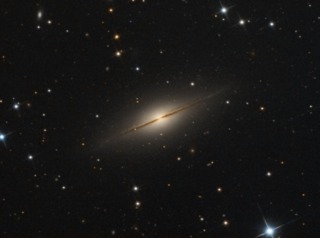
- Constellation: Pegasus
- Right Ascension: 00h 03m 14.9s
- Declination: +16° 08′ 44″
- Distance: 40 million ly
NGC 7814 is a galaxy located in the constellation of Pegasus.It resembles the more well know M104 Sombrero galaxy, but due to its increased distance, appears dimmer and smaller. It is located at an estimated distance of 40 million lightyears. Several even more distant galaxies can be seen in the image.
Imaged with the RC10 and an Atik 314l+ mono camera.
- Details
- Category: Galaxies
- Telescope: GSO RC10
- Camera: Atik 314l+